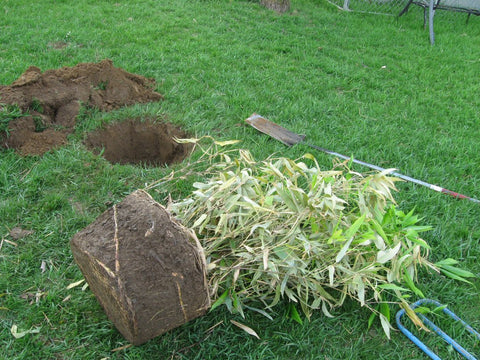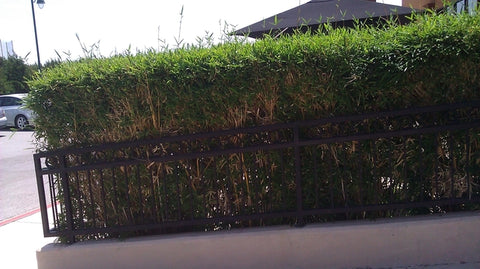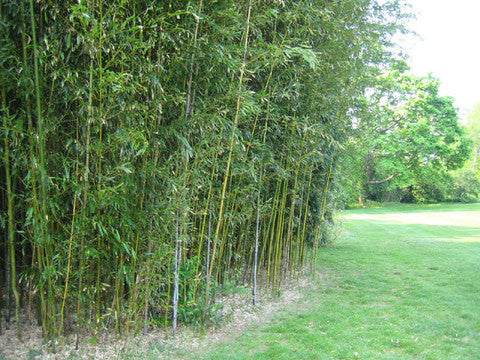How to Create Your Own Bamboo Hedge
So, you’ve decided to create your own bamboo hedge. Or maybe you are just considering it. The question is: How? In this post we will be covering why you need a bamboo hedge and all of the basic things that you need to know in order to create a healthy, thriving, beautiful and secure bamboo hedge.

Why Should You Create A Bamboo Hedge?
Creating a bamboo hedge can serve a number of purposes. They can be used to mark boundry and property lines, as well as adding aesthetic appeal your landscape. There are over 1,400 varieties of bamboo, which means that you can find them in a wide variety of sizes, shapes and colors. In addition, with a little research you can easily find out which types of bamboo will grow and thrive where you live.
There is also another, often overlooked, purpose that having a bamboo hedge can serve: security. There are a number of bamboo varieties that are extremely bushy and grow so thickly that not even small animals can’t pass through. This makes them a great security measure for protecting your home and property.
A couple varieties that we carry that are good for this type of security purpose are:
One of many reasons bamboo is a great choice for creating hedges is due to its evergreen foliage and rapid growth rate. Many varieties are cultivated specifically for their bushy appearance and hedge creating potential.
While many people believe that bamboo plants require a great deal of attention and are an invasive species, this is simply not true. The truth is that there are 2 common types of bamboos: running and clumping.
Now that you know the difference between running and clumping bamboo, you can easily choose a noninvasive clumping variety that is easy to maintain. Clumping bamboo is noninvasive and will not spread uncontrollably. In addition, clumping bamboo is available in a wide variety of different sizes, shapes and heights. In general, bamboo plants grow vertically and have a small footprint, which is why it is an absolutely great choice for hedging as it only requires a small amount of space.
While many people believe that bamboo is a high maintenance plant, the truth is that it really only requires a few basic necessities such as water and food. This is most important while plants are young, once they have become well-established they are much more resilient and hardy.
Creating A Bamboo Hedge
When creating your own bamboo hedge, there are a couple of things that you should know. By following the recommendations listed here, you can ensure that your bamboo hedge will grow quickly and thrive for many years to come.

Landscaping
The first step, is deciding exactly where you want your hedge to be. Once you know where you want your living hedge to be, you can begin by tilling up the area. While this is not absolutely necessary, it is the best way to ensure rapid growth where you want it. For example, if you are intending to plant a Seabreeze bamboo hedge, a good recommendation would be to till an area that is 2 to 4 feet wide and as long as you need.
In addition, it is only the topmost layer of soil that needs to be tilled. Finally, mix the tilled topsoil with organic materials such as compost. Not only does this ensure lots of healthy nutrients for your growing bamboos, but it also allows for more rapid growth as new shoots do not have to fight through hard, compact soil.
Alternatively, you can also dig a narrow, continuous trench using your shovel and refill it with improved soil.
Spacing
One of the most important aspects of creating your bamboo hedge is spacing. If your bamboo plants are planted too closely together, then they may not grow to their full potential. If they are planted too far apart, then this could result in large gaps in your hedge or it could take much more time than anticipated to create a full hedge.
Determining how far apart you should plant your bamboo depends on the variety that you choose. While you can generally find spacing information for any variety of bamboo online, a good rule of thumb to follow is the diameter of a fully mature clump. For example, a fully mature clump of Seabreeze bamboo has a diameter of 4 to 5 feet. Therefore, depending on your spacing needs, planting the bamboos 4 to 6 feet apart is the best choice.
Water & Food
Providing proper amounts of water and nutrients to your growing bamboo plants is absolutely one of the most important ingredients in creating your own bamboo hedge. There should be an irrigation emitter line placed along this newly created trench, in order to ensure rich and moist soil for your bamboo plants to grow in.
We recommend exploring environmentally friendly home irrigation plans. These plans typically focus on recycling water or using local water sources, such as a pond, cistern or gray water. In addition, you’ll also have to consider the actual nutrients that the clumping bamboo plants need to thrive as well.
SupremeGrower’s Bamboo Special 13-3-13 is a high nitrogen, slow release fertilizer that has been specially formulated for bamboo and palms. Made of eco-friendly controlled release modules, this fertilizer does not wash away after a couple of rainshowers. Instead, small amounts of nutrients are released for up to 350 days per year. This is the only bamboo fertilizer that we use and recommend. This means that you can save time and money by only applying fertilizer to your bamboo plants once a year, and still give them everything they need to achieve maximum results.
Maintaining A Bamboo Hedge
Now that you know how to create your own bamboo hedge, you’ll find that as your plants become established they will become more hardy and resiliant. There is also very little yearly maintenance needed. However, in order to keep your bamboo looking its very best, we do recommend an annual pruning and trimming.

Trimming
A bamboo hedge can easily be trimmed in order to maintain whatever size and shape you desire. For clumping bamboo, most recommend trimming in the winter or spring. Every summer, or shooting season, new culms emerge. We recommend culling all canes that are older than 2-3 years, these are typically found more towards the center of the clump.This promotes new foliage and redirects the plants energy back into the roots, where the majority of the bamboo’s growth takes place.
After you finish trimming your new bamboo hedge, it is recommended to apply food and water to the soil. This generally makes a big difference in the amount of time and maintenance that you have to devote to your new bamboo hedge as you can pretty much roll it into a once a year event.
Best Bamboo Hedge Varieties
There are some bamboo species that do better than others for hedging. There are also many varieties that have been specially cultivated in order to provide spectacular hedges. Some of the most popular choices for creating amazing bamboo hedges include:
Seabreeze bamboo is one of the most hardy sub-tropical varieties available. It is more salt tolerant and a great choice for coastal locations, as well as having a higher tolerance to winds and cool temperatures. Reaching maximum heights of 30 to 35 feet tall, this unique bamboo plant offers more versatility and higher success in reaching full potential.
Multiplex Hedge bamboo, as its name implies, is a Multiplex variety that has been used for centuries to create amazingly easy to maintain, attractive hedges. Typically reaching a maximum height of 15 feet, it is renowned for its small culms and stems that form perfectly interlocking, thick hedges. Whether at 6, 12 or 15 feet, these bamboo hedge plants make a great addition to any landscape.
Another favorite hedge bamboo is commonly known as Alphonse Karr, another Multiplex variety that has been cultivated for years to create beautiful and aesthetic hedges. They are often chosen for ornamental purposes due to their thin, brightly striped canes, and for their thick, impenetrable growth pattern.



